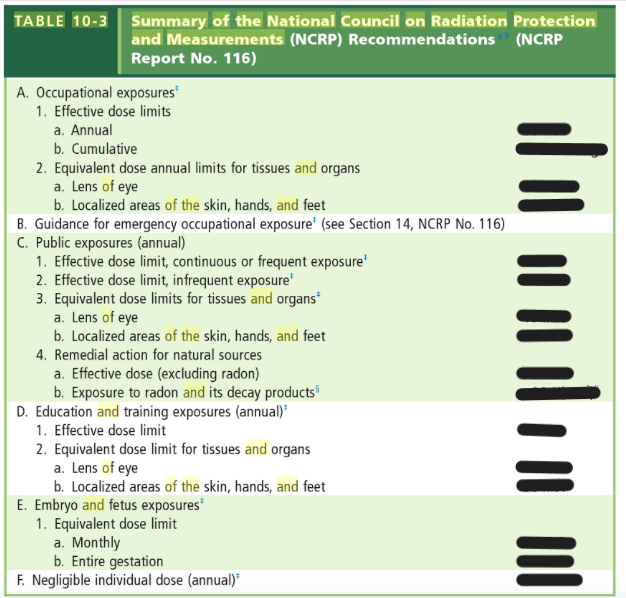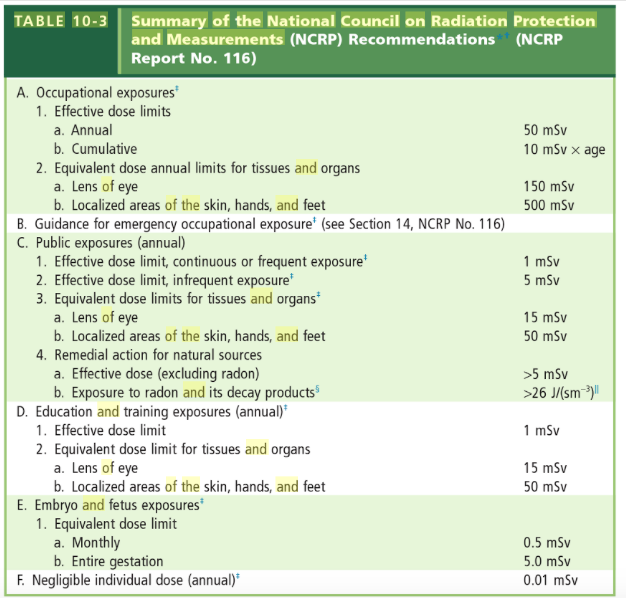Dose Limits for Exposure to Ionizing Radiation
1/67
There's no tags or description
Looks like no tags are added yet.
Name | Mastery | Learn | Test | Matching | Spaced |
|---|
No study sessions yet.
68 Terms
What is the effective dose (EfD) equation?
D x WR x WT
What is the equivalent dose (EqD) equation?
D x WR
What is the effective dose limiting system?
a set of numeric dose limits that are based on calculations of the various risks of cancer and genetic effects to tissues or organs exposed to radiation
The effective dose limiting system is based on the risk of ___
radiation-induced malignancies
The EfD limiting system limits are documented in the ___
code of federal regulations
What are the 4 radiation protection standards organizations?
ICRP
NCRP
UNSCEAR
NAS/NRC-BEIR
What is the major difference between the radiation protection standards organizations and the regulatory agencies?
radiation protection standards organizations do the research
regulatory agencies make the laws
What does ICRP stand for?
International Commission on Radiological Protection
What does NCRP stand for?
National Council on Radiation Protection and Measurements
What does UNSCEAR stand for?
United Nations Scientific Committee on the Effects of Atomic Radiation
What does NAS/NRC-BEIR stand for?
National Academy of Sciences/National Research Council Committee on the Biological Effects of Ionizing Radiation
The international authority on the safe use of sources of ionizing radiation is the ___
ICRP
What is the leading international organization responsible for providing clear and consistent radiation protection guidance?
the ICRP
The ICRP provides recommendations for ___ and ___
occupational dose limits and public dose limits
The NCRP reviews recommendations formulated by the ___, and determines how they are ___
ICRP; incorporated into US radiation protection criteria
The NCRP formulates general recommendations that are ___ for federal and state agencies
guidelines
UNSCEAR assists in the formulation of ___
radiation protection guidelines
UNSCEAR evaluates ___ and ___ ionizing radiation exposures from a variety of sources
human and environmental
UNSCEAR evaluates what sources for ionizing radiation?
radioactive materials, radiation-producing machines, radiation accidents
UNSCEAR derives radiation risk assessments for ___ and ___
radiation-induced cancer and genetic (hereditary) effects
NAS/NRC-BEIR is an advisory group that reviews studies of biologic effects of ___ and ___
ionizing radiation and risk assessment
NAS/NRC-BEIR recommends for ___ limits and ___ limits
EfD and EqD
NAS/NRC-BEIR studies groups of people who were ___
routinely or accidentally exposed to ionizing radiation (such as early radiation workers, atomic bomb victims of Hiroshima and Nagasaki, evacuees from Chernobyl)
What are the 5 U.S. regulatory agencies?
NRC
agreement states
EPA
FDA
OSHA
What does NRC stand for?
Nuclear Regulatory Commission
What does EPA stand for?
Environmental Protection Agency
What does FDA stand for?
(U.S.) Food and Drug Administration
What does OSHA stand for?
Occupational Safety and Health Administration
What organization was formerly known as the Atomic Energy Commission?
the NRC
The NRC is a federal agency that has the authority to control ___
the possession, use, and production of atomic energy in the interest of national security
Does the NRC enforce radiation protection standards or regulate x-ray imaging facilities?
enforce radiation protection standards
The NRC supervises what 4 things?
design and working mechanics of nuclear power stations
production of nuclear fuel
handling of expended fuel
hazardous radioactive waste material
Explain agreement states
agreements permit the contracting state to undertake the responsibility of licensing and regulating the use of radioisotopes and certain other radioactive materials within that state
Agreement states assume the responsibility for enforcing ___
radiation protection regulations through respective health departments
The EPA is an agency responsible for protecting ___ and safeguarding ___
protecting the health of humans
safeguarding the natural environment
The EPA facilitates the development and enforcement of regulations pertaining to ___
the control of radiation in the environment
The FDA conducts ___ and ___
product radiation control programs
regulating design and manufacturing of electronic products (including Dx x-ray equipment)
Which organization conducts onsite inspections of x-ray equipment?
FDA
Which organization makes sure employees’ “right to know” with regard to hazard material is present in the workplace?
OSHA
OSHA regulates occupational exposure through ___
the US Code of Federal Regulations
The ___ ensures adequate safety of patients and radiation workers
radiation safety program
The NRC mandates that a radiation safety committee be established for a facility for ___
guidance of the safety program and facilitating ongoing operation
What 2 things is the radiation safety officer selected to do?
oversee the program’s daily operation
provide for formal review of program each year
According to federal regulations, a radiation safety program must have detailed procedures for handling and disposal of ___
radioactive materials
Containers are kept for a period of ___ half lives
10
Explain the Radiation Control for Health & Safety Act of 1968
protect the public for hazards of unnecessary radiation exposure from electronic products
assess biologic effects of ionizing radiation
evaluate radiation emissions from electronic products
conduct research to reduce radiation exposure
Another term for ALARA is ___
ORP (optimization for radiation protection)
The relationship between ionizing radiation and potential risk follows a ___ model
linear non-threshold
Explain the FDA “white paper” (2010)
follows the premise that each patient should get the right imaging exam at the right time with the right dose
promotes safe use of medical imaging devices
supports informed clinical decisions
increases patient awareness
Explain the Consumer-Patient Radiation Health and Safety Act of 1981
provides federal legislation requiring minimal standards for the accreditations of education programs for persons who perform radiologic procedures and the certification of such persons
Requires federal laws that set basic standards for accrediting education programs for people who perform radiologic procedures and certifying those individuals.
ensures that medical and dental radiologic practices adhere to safety standards
Tissue reactions are ___ that can be directly related to the dose received
biologic somatic effects of ionizing radiation
Tissue reactions exhibit a ___ dose
threshold
Erythema, decreased WBCs, epilation/alopecia, and acute radiation syndrome are examples of ___
early tissue reactions
Cataracts, fibrosis, atrophy, cell loss, reduced fertility, and sterility are examples of ___
late tissue reactions
Stochastic effects follow the assumption that ___
no minimal safe dose exists (any dose, no matter how small, can not be considered safe)
randomly occuring
___ effects are non-threshold
stochastic
Cancer and genetic alterations are examples of ___
stochastic effects
Define deterministic (tissue) effects
effects that occur in all individuals who receive greater than the threshold dose and for which the severity of the effect varies with the dose
What is the current method for controlling risk of biologic damage to radiation workers and the general public from radiation exposure?
effective dose (EfD) limiting system
What does EDL stand for?
effective dose limit
What is the EDL?
upper boundary dose of ionizing radiation that results in negligible risk of bodily injury or hereditary damage
Evidence of dose-dependent increase in the incidence of severe intellectual disability for fetal doses greater than ___
0.4 Sv
Greatest risk for intellectual disability occurred when embryo-fetus was exposed ___ weeks after conception
8-15
What is the Cumulative Effective Dose (CumEfD) limit?
lifetime EfD must be limited to age in years times 10 mSv
The ICRP wants to decrease EfD limit from 50 mSv annually to ___ mSv annually
20


What are action limits?
limits for occupational exposure that are set by the medical facility well below the regulatory values (purpose is to trigger an investigation when they are exceeded)
What is radiation hormesis?
concept that there is a beneficial result from continuing exposure to small amounts of radiation (IS NOT PROVEN)